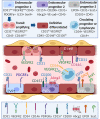Current concepts on endothelial stem cells definition, location, and markers
- PMID: 34724714
- PMCID: PMC8560200
- DOI: 10.1002/sctm.21-0022
Current concepts on endothelial stem cells definition, location, and markers
Abstract
Ischemic vascular disease is a major cause of mortality and morbidity worldwide, and regeneration of blood vessels in perfusion-deficient tissues is a worthwhile therapeutic goal. The idea of delivering endothelial stem/progenitor cells to repair damaged vasculature, reperfuse hypoxic tissue, prevent cell death, and consequently diminish tissue inflammation and fibrosis has a strong scientific basis and clinical value. Various labs have proposed endothelial stem/progenitor cell candidates. This has created confusion, as there are profound differences between these cell definitions based on isolation methodology, characterization, and reparative biology. Here, a stricter definition based on stem cell biology principles is proposed. Although preclinical studies have often been promising, results from clinical trials have been highly contradictory and served to highlight multiple challenges associated with disappointing therapeutic benefit. This article reviews recent accomplishments in the field and discusses current difficulties when developing endothelial stem cell therapies. Emerging evidence that disputes the classic view of the bone marrow as the source for these cells and supports the vascular wall as the niche for these tissue-resident endothelial stem cells is considered. In addition, novel markers to identify endothelial stem cells, including CD157, EPCR, and CD31low VEGFR2low IL33+ Sox9+ , are described.
Keywords: angiogenesis; blood vessels; circulating endothelial progenitor cells; endothelial colony-forming cells; endothelial stem cells; neovascularization; vascular repair.
© 2021 The Authors. STEM CELLS TRANSLATIONAL MEDICINE published by Wiley Periodicals LLC on behalf of AlphaMed Press.
Conflict of interest statement
The authors declared no potential conflicts of interest.
Figures


References
-
- Lacaud G, Kouskoff V. Hemangioblast, hemogenic endothelium, and primitive versus definitive hematopoiesis. Exp Hematol. 2017;49:19‐24. - PubMed
-
- Loges S, Fehse B, Brockmann MA, et al. Identification of the adult human hemangioblast. Stem Cells Dev. 2004;13:229‐242. - PubMed
-
- Grant MB, May WS, Caballero S, et al. Adult hematopoietic stem cells provide functional hemangioblast activity during retinal neovascularization. Nat Med. 2002;8:607‐612. - PubMed
Publication types
MeSH terms
Substances
Grants and funding
LinkOut - more resources
Full Text Sources
Research Materials
Miscellaneous

